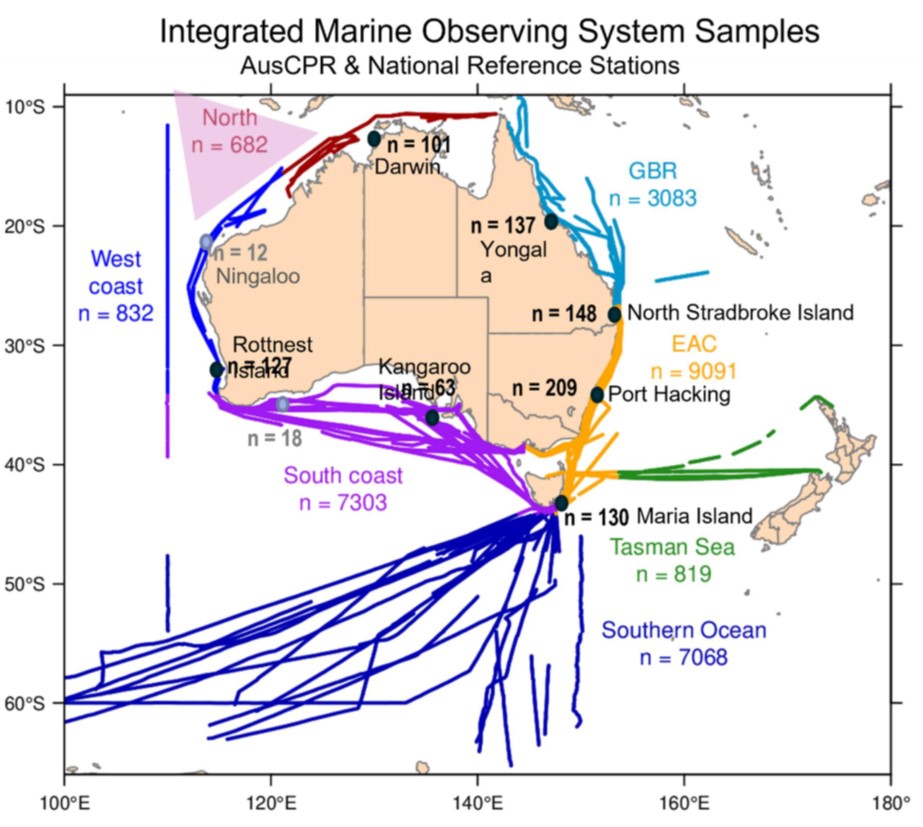
I came on this voyage to help put the Z in BLOOFINZ. Our long-term plankton surveys in Australia use the Continuous Plankton Recorder (CPR) to cover large spatial and temporal scales around the coastline of Australia, and a Heron drop net for monthly sampling at a finer resolution at 7 National Reference Stations. Note the lower number of samples taken in the North and West of the region, which the BLOOFINZ study area covers, pink triangle, – this area has been poorly sampled in the past, so aside from the specific voyage objectives this was also an unmissable opportunity to fill those gaps.

The CPR is a tried and trusted method of collecting plankton over large spatial and temporal scales. As the CPR is towed through the water a propellor on the instrument turns a series of cogs which wind rolls of silk between which plankton is trapped. The CPR has been sampling the plankton in the North Atlantic for over 90 years. In Australia we have been towing the CPR for ~13 years, primarily from ships of opportunity, and have produced comprehensive data on plankton distribution, phenology and resultant time series from the Great Barrier Reef, down along the east coast round to the Great Australian Bight in the south.
The Heron net was chosen for the IMOS sampling at the National Reference Stations in part for its simplicity and the fine mesh. A 100 micron mesh net captures most of the zooplankton diversity, including the highly abundant small and juvenile copepods and components of the zooplankton which can provide information on the pathways through which energy is transferred up the food web, i.e. mixotrophic microzooplankton and the pelagic tunicates that can shunt energy efficiently through the system. To collect a sample the net is literally dropped into the ocean and it falls through the water at 1 ms-1, eliminating the requirement for a flowmeter. Once the required depth is attained, 100 m = 100 seconds, the rope is pulled taut which closes the sheathing mechanism around the neck of the net. The net can then be hauled back onto the boat. This net is predominantly used on small boats so we had to adapt the method to R/V Revelle. See the video to watch the net retrieval which required a burst of energy and was usually accompanied by laughter.

Upper panels: CPR recovery and deployment. Lower panels: Heron net deployment and recovery.
The oligotrophic conditions in this area mean that the dominant phytoplankton are small, photosynthetic bacteria and the transfer of energy via zooplankton through the food web to fish is complex and consists of multiple pathways. The compositional data from our sampling informs us how the food environment changes spatially relative to the ocean features and is important for understanding food availability and trophic processes. In the context of BLOOFINZ studying the zooplankton helps us understand: 1) the mechanism of energy transfer through the food web; 2) what zooplankton is available for the larval tuna and which they may be selecting. Looking at the bigger picture this data is also filling a gap in a poorly sampled area, allowing us to create better data products, for example, inputs for biogeochemical and ecosystem models. These models require more zooplankton data for model assessment as there is a growing realisation that zooplankton have been overlooked with most modelling effort with assessment to date focused on phytoplankton and fish. This new data will help us provide more comprehensive zooplankton information across the Australian continent.
Claire Davies is a plankton biologist and data scientist from CSIRO in Australia. She is part of the IMOS/CSIRO plankton team which comprises 8 scientists working out of Brisbane and Hobart. Since 2008 they have been running two long-term plankton monitoring surveys in Australian waters using funding through the Integrated Marine Observing System (IMOS).
Follow our surveys on facebook: https://www.facebook.com/imosaustralianplanktonsurvey
Learn more about IMOS and our surveys at:
https://imos.org.au/facilities/shipsofopportunity/auscontinuousplanktonrecorder
https://imos.org.au/facilities/nationalmooringnetwork/nrs
Look at how our data can be used to understand the changing conditions around Australia’s coastlines in the IMOS Status and Trends report: https://www.imosoceanreport.org.au
